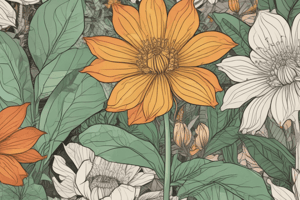Podcast
Questions and Answers
What is the main function of flowers in plants?
What is the main function of flowers in plants?
- To produce energy through photosynthesis
- To provide support for the plant
- To store excess water for the plant
- To serve as reproductive organs (correct)
Which part of the flower produces pollen?
Which part of the flower produces pollen?
- Pistils
- Ovaries
- Anthers (correct)
- Stigma
What is the process by which pollen is transferred to the stigma of the flower's ovaries or pistils?
What is the process by which pollen is transferred to the stigma of the flower's ovaries or pistils?
- Fertilization
- Photosynthesis
- Pollination (correct)
- Germination
Which of the following is a method of asexual reproduction in plants?
Which of the following is a method of asexual reproduction in plants?
In which process do the male and female gametes unite to form offspring?
In which process do the male and female gametes unite to form offspring?
What is the purpose of seed dispersal in plants?
What is the purpose of seed dispersal in plants?
What is the main outcome of asexual reproduction in plants?
What is the main outcome of asexual reproduction in plants?
What is the main difference between vegetative reproduction and apomixis?
What is the main difference between vegetative reproduction and apomixis?
What is the process of pollination in plants?
What is the process of pollination in plants?
Why is pollination essential for sexual reproduction in flowering plants?
Why is pollination essential for sexual reproduction in flowering plants?
What is the purpose of seed dispersal in plants?
What is the purpose of seed dispersal in plants?
Which statement best describes asexual reproduction in plants?
Which statement best describes asexual reproduction in plants?
What role do pollinators play in plant reproduction?
What role do pollinators play in plant reproduction?
Flashcards are hidden until you start studying
Study Notes
Reproduction in Plants
Plants are essential components of ecosystems, and their reproduction is crucial for the continuation of their species. They can reproduce both sexually and asexually, with each method having its own advantages and disadvantages. In this article, we will explore the various aspects of plant reproduction, focusing on flower structure, fertilization, asexual reproduction in plants, pollination, and seed dispersal.
Flower Structure
Flowers are the reproductive organs of plants, and their structure varies depending on the species. They typically consist of two main parts: the male reproductive organs (anthers) and the female reproductive organs (ovaries or pistils). The anthers produce pollen, which contains the male gametes, while the ovaries or pistils produce egg cells, which are the female gametes.
Fertilization
Fertilization is the process where the male and female gametes unite, resulting in the formation of offspring. In flowering plants, pollination is the process by which pollen from the anthers is transferred to the stigma of the ovaries or pistils. This transfer can occur through self-pollination, where the plant's own pollen fertilizes its own ovules, or cross-pollination, where the wind or animals move pollen from one plant to another.
Asexual Reproduction in Plants
Asexual reproduction allows plants to propagate themselves without the need for fertilization. This method produces offspring that are genetically identical to the parent plant. There are two main types of asexual reproduction in plants: vegetative reproduction and apomixis. Vegetative reproduction results in new plant individuals without the production of seeds or spores, while apomixis involves the production of seeds without fertilization.
Pollination
Pollination is the process by which pollen is transferred from the anthers of a flower to the stigma of another flower. This process can be facilitated by pollinators, such as animals or wind, which help transfer pollen between flowers. Pollination is essential for sexual reproduction in flowering plants, as it allows the exchange of genetic material between male and female gametes.
Seed Dispersal
Seed dispersal is the process by which seeds are moved away from the parent plant, increasing the chances of them growing in an area with plenty of resources. Many plants have special features to help with seed dispersal, such as structures that help seeds stick to an animal's fur or seeds that can be carried by wind or water. Seed dispersal is crucial for the success of plants, as it allows their offspring to colonize new areas and adapt to changing environmental conditions.
In conclusion, plant reproduction is a complex process that can occur through both sexual and asexual means. Flower structure, fertilization, asexual reproduction, pollination, and seed dispersal are essential aspects of plant reproduction, allowing plants to adapt and thrive in various environments.
Studying That Suits You
Use AI to generate personalized quizzes and flashcards to suit your learning preferences.




